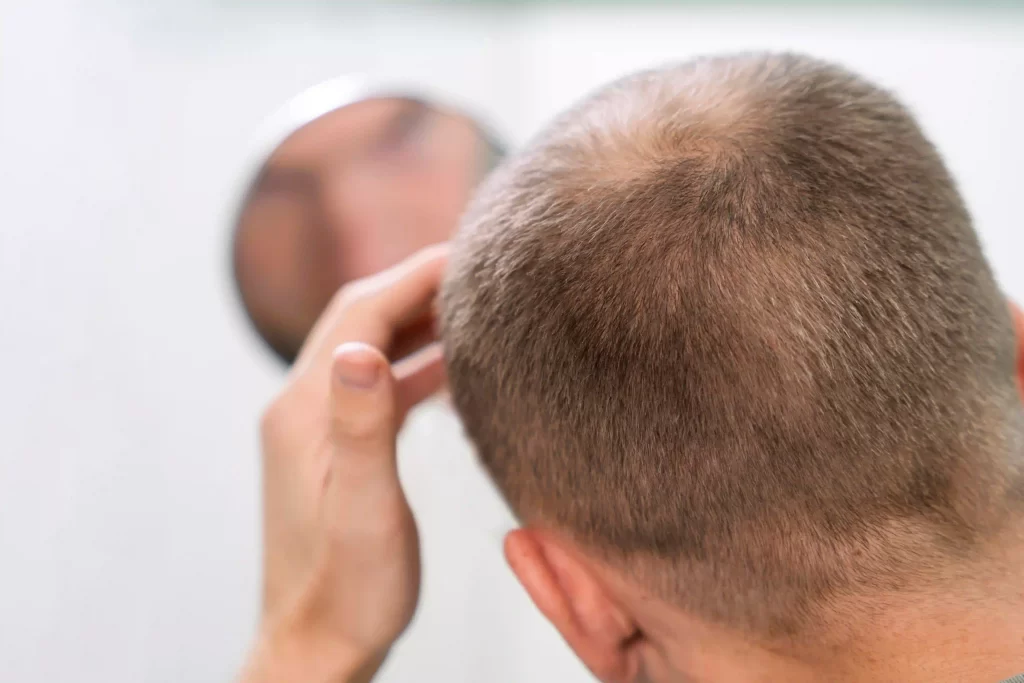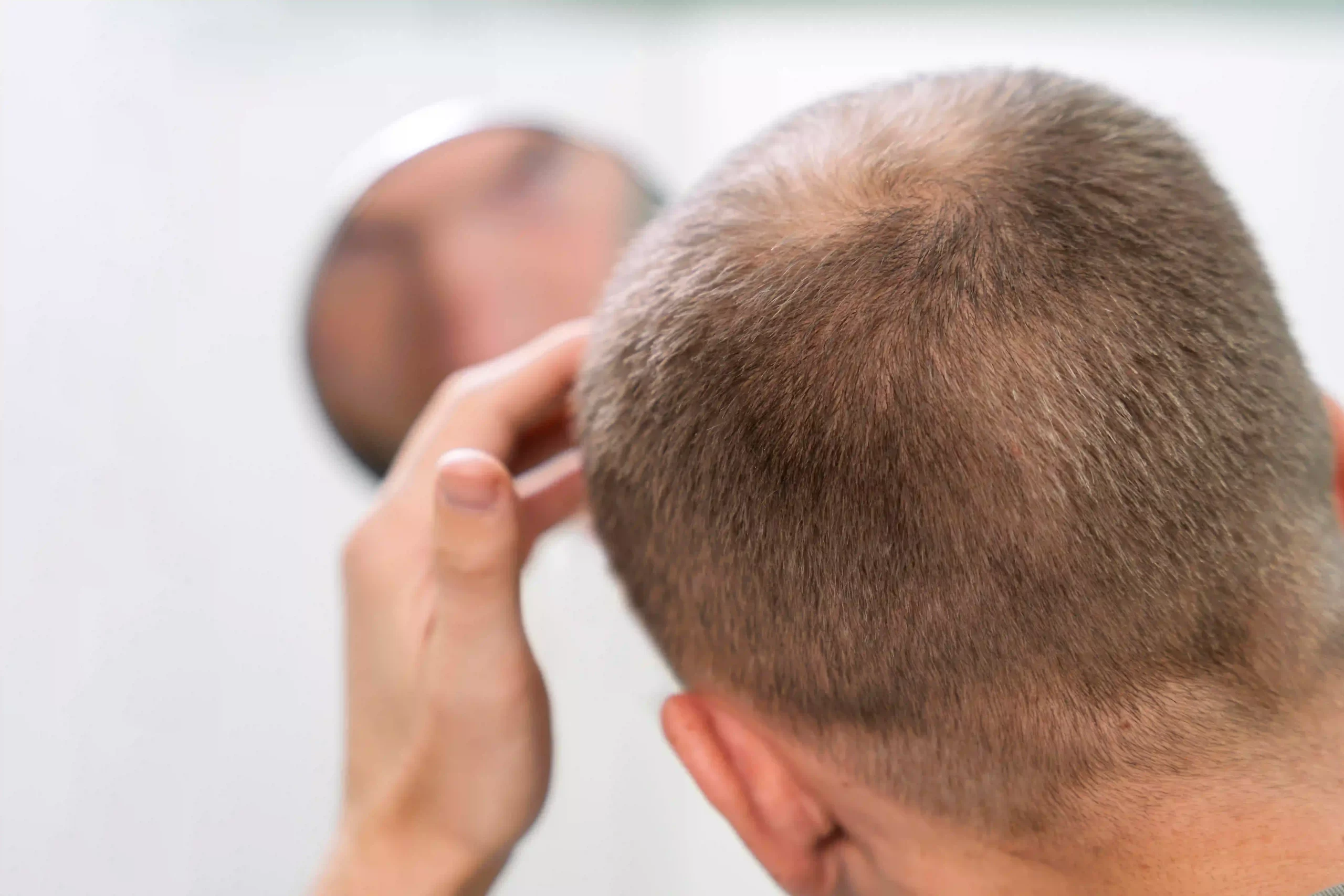Hair loss can affect anyone, young or old, though it’s more prevalent in older adults. Let’s learn about the causes of your hair loss before starting any treatment.
According to the American Academy of Dermatology (AAD), losing 50 to 100 hairs daily is normal; new hair naturally replaces what’s shed.
It’s more than just a cosmetic issue – it can impact our confidence and feelings about ourselves.
Understanding the reasons for hair loss is the first step toward finding solutions and feeling reassured. You’re not alone in this journey; there are ways to navigate it with support and compassion.

Common Causes of Hair Loss
Hair loss is a widespread concern, with various types ranging from common to rare occurrences, each with distinct underlying causes.
The reasons behind hair loss can be attributed to genetics, internal factors, or external influences. Let’s delve into a few different types of hair loss and their causes:
Androgenic Alopecia:
Androgenic alopecia, commonly known as hereditary hair loss or pattern alopecia, encompasses conditions like male pattern baldness and female pattern baldness. This common type of hair loss, affecting up to 50% of individuals, usually progresses gradually. Symptoms may appear as early as puberty or later in life.
- Female Pattern Baldness: This variation often leads to widespread thinning across the scalp, resembling a widening or thinning around the part.
- Male Pattern Baldness: In males, this condition involves progressive hair loss above the temples and thinning at the crown, creating an “M” shape.
Alopecia Areata:
Alopecia areata is a unique kind of hair loss where bald patches appear. It happens because the immune system mistakenly attacks the hair follicles. This can lead to sudden hair loss on the scalp, eyebrows, or even the entire body. The precise cause involves a combination of genetic and environmental factors.
Telogen Effluvium:
Telogen effluvium is a kind of sudden hair loss that happens when our bodies go through big changes or stress, like a tough time or a serious illness. It can also happen because of hormonal shifts like childbirth, postpartum, menopause, or other reasons like not getting enough nutrients, certain disorders, or starting or stopping birth control. The good news is that once the main reason is fixed, this type of hair loss usually gets better on its own.
Scarring Alopecia:
Scarring alopecia is when scars on the scalp stop hair from growing back. Inflammation damages hair follicles, replacing them with scar tissue. Unlike other hair loss, scarring alopecia is permanent, meaning hair won’t grow back in affected areas. It can be caused by medical conditions or scalp injuries.
Other Contributors to Hair Loss
Our daily lives play a significant role in the health of our hair. Explore how stress and emotional well-being, as well as diet and exercise, impact the vitality of your locks.
Stress and Emotional Health:
Stress confuses the immune system, leading to inflammation. This inflammation disrupts the routine of hair-growing follicles, causing potential hair loss.
When we find ways to manage stress and keep our minds in a good place, we’re not only helping ourselves feel better but also giving our hair a better chance to stay healthy and vibrant.
Quick Tips for Stress-Free Hair:
- Breathe Deep: Practice deep breathing exercises to ease stress.
- Daily Breaks: Take short breaks throughout the day for relaxation.
- Positive Vibes: Surround yourself with positive influences for emotional well-being.
- Self-Care Routine: Establish a self-care routine to prioritize mental health.
- Express Yourself: Talk to friends or seek professional support when needed.
Diet and Exercise:
Your diet plays a crucial role in maintaining healthy hair. Lack of essential nutrients like iron, vitamin D, and zinc, along with low-calorie diets and protein restriction, can contribute to hair loss.
While some supplements can help, excessive doses of certain vitamins and minerals may lead to hair loss.

Lifestyle factors like smoking and excessive alcohol can also affect hair. Insufficient sleep disrupts hormones and increases stress, contributing to hair loss.
Regular exercise, by improving circulation and reducing stress, may indirectly support hair health.
Quick Tips for Healthy Hair:
- Hydration Hacks: Drink a minimum of 8 glasses of water daily.
- Balanced Bites: Mix fruits, veggies, lean proteins, whole grains, and healthy fats in your meals.
- Move It, Boost It: Walk or jog for 30 minutes daily for better blood flow.
- Protein Punch: Aim for 0.36 grams of protein per pound for strong, vibrant hair.
Pollution and Hair Damage:
Air pollution can mess with your hair and scalp, even making you lose hair like in male-pattern baldness. It can also make your scalp itchy and inflamed and mess with your hair’s strength.
Simple Tips for Protecting Hair from Pollution:
- Cover Up: Wear a hat or scarf to shield hair from pollutants.
- Rinse Regularly: Wash hair frequently to remove pollutants and dirt.
- Conditioning Shield: Use a conditioner to create a protective barrier on your strands.
- Hydration Boost: Stay well-hydrated to support overall hair health.
Heat and Styling Damage:
Using hot tools like blow dryers, flat irons, and curling irons increases the chances that you’ll experience damaged hair from heat.
Exposure to high heat changes the shape of your hair’s keratin strands. When the keratin is melted, your hair maintains that shape on a molecular level, and it’s not reversible.
The chemicals in hair styling products can damage hair roots and make hair dry and prone to breakage.
Overusing certain styling products, particularly those containing harsh chemicals, can contribute to hair damage. This can lead to dryness, breakage, and potential hair loss.
Simple Tips for Safe Heat Styling:
- Protect First: Apply a heat protectant before using hot tools.
- Low Heat, High Care: Set tools to the lowest effective temperature.
- Time Check: Minimize heat exposure to safeguard your hair.
- Dry Before Style: Avoid styling wet hair to prevent damage.
- Use Wisely: Limit heat tool use to 2-3 times weekly, with lower heat for delicate hair.
Conclusion:
In the realm of hair loss causes, understanding its diverse origins—from genetic factors to lifestyle influences—is the first step toward effective solutions.
Whether dealing with androgenic alopecia, alopecia areata, telogen effluvium, or scarring alopecia, each condition has its unique characteristics and potential paths to resolution.
Beyond medical factors, our daily lives significantly impact hair health. Managing stress, maintaining a balanced diet, incorporating exercise, protecting against pollution, and practicing safe heat styling contribute to vibrant locks.
Ultimately, hair reflects overall well-being. If you experience significant hair loss that impacts your confidence, book a professional consultation with Korean Hairline. We can assist you with a hair system to boost your confidence.
Ready to take the next step? Book a consultation with us for personalized insights and support in your hair care journey.
Act now to address your hair loss causes. Book a consultation with Korean Hairline for personalized insights and support.

